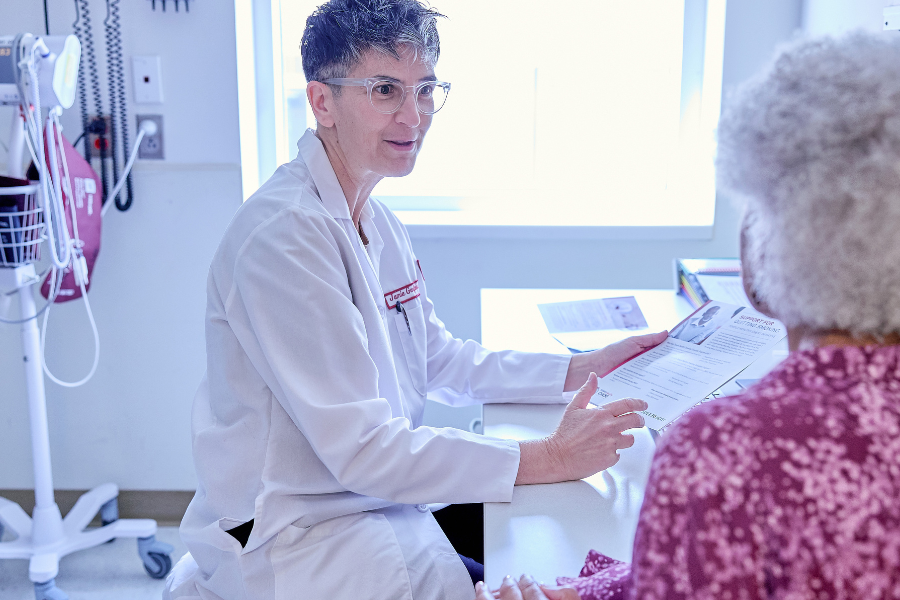They don't think of themselves as "miracle workers," but 45-year-old Heather Frantz puts two Temple physicians – surgeon Yoshiya Toyoda, MD, PhD and cardiologist Paul Forfia, MD, – into that category.
For Frantz, what else would you call the clinical team who finally diagnosed her condition correctly, induced 'clinical death' and chilled her body in order to perform a delicate surgical procedure, and gave her back the ability to breathe so she could return to her family and a bright future.
It all started earlier this year, when the Bucks County resident suddenly and inexplicably began to have trouble breathing. Within days, regular tasks like taking a shower, folding laundry, or doing the dishes became utterly exhausting, as her shortness of breath persisted and anti-allergy medicine didn't help. "I was just trying to survive each day," recalls Frantz.
After two months, two harried trips to a suburban Emergency Room, and several medications and tests later, Frantz's physician referred her for further consultation to Temple University Hospital.
Making the Diagnosis
"When I first met Heather in mid-June, she was unable to slowly walk 10 feet down the hall without feeling intensely short of breath," says Dr. Forfia, Medical Director of Pulmonary Hypertension and the Right Heart Failure Program at Temple Heart and Vascular Center. "She had been previously diagnosed with an acute pulmonary embolism in her right lung, which is a blood clot that makes its way from the lower extremities through the bloodstream to the lung. But, her situation was more complicated," he adds.
In addition to the blood flow being blocked to 90 percent of her right lung, she also had a significant blood clot in the lower-lobe of her left lung. As a result, she was immediately admitted to Temple and placed on standard blood thinners for a week, but that did not eliminate the clots.
Meanwhile, Dr. Forfia, an expert in chronic thromboembolic pulmonary hypertension (CTEPH), a condition resulting from a blood vessel blocked by a clot for a long period of time, recognized that Frantz was a good candidate for an uncommon but potentially curative procedure known as a Pulmonary Thromboendarterectomy (PTE). Having recently spearheaded a PTE Program at Temple, he knew he could rely on the surgical skills of Dr. Toyoda, Vice Chief of Cardiothoracic Surgery, Surgical Director of Heart and Lung Transplantation, and Surgical Director of Mechanical Circulatory Support.
In the Operating Room
During PTE, the patient's chest is opened up to allow access to the heart and lungs – after which the surgeon makes a small incision in the patient's pulmonary artery – the main blood vessel to the lung. "But to enter the vessel safely to remove the clot, we need to first divert the blood flow by placing the patient on a heart-bypass machine and turning it off for short periods of time – putting them into circulatory arrest – while cooling their bodies to 68 degrees Fahrenheit," explains Dr. Toyoda. During that time, the patient is in a state of hibernation and is considered 'clinically dead.'
"After having the procedure explained to me, I was naturally quite nervous," said Frantz, "but I had every confidence in Dr. Forfia and Dr. Toyoda."
To remove the clots, which in Frantz's case were attached to the walls of her pulmonary arteries, Dr. Toyoda used forceps to gently peel the clot away from the vessels. The entire operation took about eight hours, during which her heart was stopped for 137 minutes and blood flow to the brain for about 11 minutes – in two phases, one for each of Frantz's lungs. "I use the heart-lung machine for cardiac and lung transplant surgeries, and many of those techniques also apply to PTE surgery," Dr. Toyoda notes.
Recovery & Prognosis
As for Heather, her prognosis for a healthy future is excellent. "She felt dramatically better after the operation, and should be back to a regular lifestyle within six to eight weeks following the procedure," explains Dr. Forfia.
"Everyone at Temple was incredibly nice to me and I'm grateful to Drs. Forfia and Toyoda for helping me breathe easily again," says Frantz, a beach lover and avid motorcyclist. "Now, I can have entire conversations again without panting. I’m looking forward to doing the 'regular' activities of living, and easing my way back into the flow of humanity," she adds.


